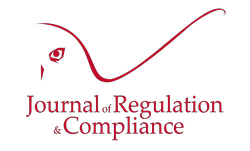The recent news

Oct. 22, 2021
Publications
 ► Référence complète : Frison-Roche, M.-A., Compétitivité des mécanismes d'alertes et des obligations de vigilance, document de travail, juillet 2021.
► Référence complète : Frison-Roche, M.-A., Compétitivité des mécanismes d'alertes et des obligations de vigilance, document de travail, juillet 2021.
____
🎤 ce document de travail sert de base à une conférence, dans le colloque Effectivité de la Compliance et Compétitivité internationale, coorganisé par le Journal of Regulation & Compliance (JoRC) et le Laboratoire d'économie du droit de l'Université Panthéon-Assas), se tenant le 4 novembre 2021, Salle des Conseils, Université Panthéon-Assas (Paris II).
____
📝Ce document de travail constitue aussi la base d'un article. Cet article sera publié ⤵
📕dans sa version française dans l'ouvrage Les buts monumentaux de la Compliance, dans la collection 
📘dans sa version anglaise dans l'ouvrage Compliance Monumental Goals, dans la collection 
____
► Résumé du document de travail : Les "outils de la compliance" sont très divers. S'il a été choisi de traiter plus particulièrement parmi ceux-ci l'obligation de vigilance et le lanceur d'alerte, ceux-là plutôt que d'autres et de les réunir, c'est parce qu'ils présentent au regard du sujet spécifique choisi, à savoir "la compétitivité internationale", et celle des entreprises, et celle de la zone économique considérée, et du système juridique indissociable de celle-ci, une unité : ce sont des mécanismes qui font sortir de l'information.
Sur ordre de la Loi, l'entreprise va non seulement cesser d'ignorer ce qu'elle recouvrait du mouchoir que Tartuffe le tendait ou qu'une conception du Droit des sociétés lui permettait légitimement d'ignorer. Il ne s'agit pas ici d'examiner si cette révolution que le Droit de la Compliance exprime dans le système juridique est d'une part légitime et d'autre part effective, mais d'essayer de mesurer ce qu'il en est au regard de la "Compétitivité internationale".
Le Droit de la Compliance sera donc ici examiné à travers ses instruments (et non par rapport à sa normativité, laquelle réside dans ses "Buts Monumentaux"). Or, ses instruments ont pour objet l'information et la mise à disposition de cette information, dans sa présentation, dans son intelligibilité et surtout dans les mains de ceux qui sont aptes à en faire "bon usage" pour que les Buts du Droit de la Compliance soient atteints.
Au regard de cette notion centrale qu'est l'information,la compétitivité internationale va être plus particulièrement concernée parce que le Droit de la Compliance va obliger l'entreprise à aller elle-même rechercher, puis exposer au regard de tous, notamment de ses concurrents, ses faiblesses, ses projets, ses alliances, ses failles. Cela ne pose pas de difficulté si ses compétiteurs sont eux-mêmes souvent à cette nouvelle loi, qui va bien au-delà de la transparence, laquelle est déjà un mécanisme nouveau car une entreprise n'est pas une organisation transparente et le Droit de la concurrence qui régit les entreprises ordinaires n'a jamais exigé cela, régit également les compétiteurs. Mais si ceux-ci ne sont pas soumis à cette loi si particulière qu'est le Droit de la Compliance, alors il y a distorsion de compétitivité du fait même du Droit.
Certes, l'on peut dire que les marchés aiment la vertu, qu'ils lui accordent crédit car ils sont eux-mêmes basés sur l'idée de "promesse", laquelle repose ultimement sur un concept moral, mais cette mise à disposition d'informations multiples à autrui, lequel autrui demeure opaque est un problème majeur de compétitivité, que le concept de "loyauté des pratiques commerciale" ne prend que très partiellement en charte.
C'est pourquoi il convient d'examiner tout d'abord ce qu'il en est de la puissance économique et financière de l'information captée par l'entreprise sur elle-même que le Droit de la Compliance peut rendre disponible à tous, ce qui produit une asymétrie de puissance à laquelle le Droit de la Compliance ne semble pas avoir encore répondu (I). Mais le Droit de la Compliance oblige aussi les entreprises à rendre compte non seulement à ce qu'elles font mais encore à ce que font les autres pour elles. A travers l'obligation de vigilance, obligation objective et Ex Ante, à laquelle s'arrive le pouvoir du lanceur d'alerte, l'entreprise obtient un pouvoir d'information sur autrui qui pourrait bien résoudre ce qui est souvent présentée comme la dispute aporétique de l'extraterritorialité du Droit de la Compliance, rendant alors comptable les entreprises jusqu'ici protégées par leur système juridique "préservé" et atteint de ce fait par l'effectivité du Droit de la Compliance (II).

Oct. 20, 2021
Publications

🌐follow Marie-Anne Frison-Roche on LinkedIn
🌐subscribe to the Newsletter MAFR Regulation, Compliance, Law
____
 ► Full Reference: M.-A. Frison-Roche, Support from Compliance Law for day-to-day management of Competition Law, Working Paper, Octobre 2021.
► Full Reference: M.-A. Frison-Roche, Support from Compliance Law for day-to-day management of Competition Law, Working Paper, Octobre 2021.
_____
► This working paper has been drawn up as a basis for a contribution to the Amicorum Liber for Professor Laurence Idot, published in 2022
____
► Working Paper Summary: Competition Law has become so huge and just "regulations" that one would give up trying to understand it as a whole, preferring to become a specialist in one of its parts. This would be to lose sight of the simple and strong reason which unites the whole and gives it its breath: Freedom. Freedom experienced by the person in his daily economic action, Freedom kept by Competition Law, always returning to its principle: Free Competition. This is why the European Union places a so great emphasis on Competition. To build it and keep it effective, "Competition Policy" is articulated with Competition Law, but if authorities and judges do not blame companies for their power, they do not rely on it. To do this, they must then be supported by Compliance Law, which strongly encourages companies to act for the effectiveness and the promotion of Competition principles. Competition Law thus slips from the Ex Post to the Ex Ante, with the commitments of companies leading them to stop being passive and punished in order to become convinced players and educators of the others. Something pleasant for a great professor of Competition Law, to whom tribute is paid here.
____
🔓read the Working Paper below⤵
Oct. 18, 2021
Interviews

► Référence complète : Frison-Roche, M.-A., entretien avec Laurence Neuer, Bien commun : "les entreprises sont avant tout faites pour gagner de l'argent" , 18 octobre 2021.
____
► Lire l'entretien (réservé aux abonnés)
____
Entretien mené à propos du lancement d'alerte réalisé sur Facebook en octobre 2021 sur l'effet d'Instagram sur les jeunes filles.
Les questions posées étaient les suivantes :
Quel est le véritable « pouvoir » des lanceurs d’alertes ? Une entreprise peut-elle fixer en son sein des normes éthiques ? Comment l’amener à être plus « vertueuse » ? Les réponses de Marie-Anne Frison-Roche, Professeur de droit économique à l'Institut d'études politiques de Paris et spécialiste du droit de la régulation et de la compliance.
Le Point : ❓ Plus personne n’est à l’abri face à la puissance des lanceurs d’alertes, surtout aux États-Unis !
Réponse MaFR
Le Point : ❓ Ce qui est moins le cas en Europe et en France…
Réponse MaFR
❓ La crédibilité du lanceur d’alerte est d’autant plus forte que cette personne intervient de manière désintéressée…
Réponse MaFR
❓ Facebook a fait valoir ses arguments en « défense » à la presse et au Congrès, mais le « procès » se déroule en grande partie sur la place publique
Réponse MaFR
❓ Ce débat va-t-il se poursuivre devant la justice ?
Réponse MaFR
❓ Peut-on demander à une entreprise de se montrer « vertueuse » ? Et où placer le curseur ?
Réponse MaFR
❓ Comment « réguler » l’influence considérable des plateformes sur nos vies ?
Réponse MaFR
❓ Une « raison d’être » qui a été introduite dans le droit français par la Loi Pacte de 2019….
Réponse MaFR
❓ N’est-ce pas d’une certaine manière la façon dont fonctionne le conseil de surveillance de Facebook (l’Oversight Board) qui s’est récemment prononcé sur la suspension du compte de Donald Trump ?
Réponse MaFR
❓ Certaines entreprises se posent néanmoins en constituants ou en législateurs, notamment Facebook ou Google qui disent agir en application de leurs seuls « standards de communauté »…
Réponse MaFR
_____
Oct. 14, 2021
Conferences

► Full Reference: Frison-Roche, M.A., Definition of Principle of Proportionality and Definition of Compliance Law ("Définition du Principe de Proportionnalité et Définition du Droit de la Compliance"), in Frison-Roche, M.-A. et Rapp, L. (dir.), Compliance and Proportionality. From the control of Proportionality to the proportionality of the Control ("Compliance et proportionnalité. Du contrôle de proportionnalité à la proportionnalité du contrôle") Compliance et Proportionnalité. Du contrôle de proportionnalité à la proportionnalité du contrôle, juges pour la Compliance, Colloque coorganisé par le Journal of Regulation & Compliance (JoRC) et la Chaire SIRIUS (IDETCOM), 14 octobre 2021.
____
📅 read the conference program
📅 this colloquium is part of the cycle of colloquia 2021 organised by the Journal of Regulation & Compliance (JoRC) and its partners on the Compliance Monumental Goals topic.
____
🚧 read the Working Paper on the basis of which the conference was done and from which the reactions took place.
____
►see the slides supporting the conference (in French)
► Conference Summary: The use of Proportionality t always limit powers is only justified when it is about sanctions, but sanctions are only one tool among others in Compliance Law, intended moreover to have little place in this Ex Ante branch of Law. And returning to the very nature of Compliance Law, which relies on operators, private or public, because they are powerful, then using proportionality to limite powers is detrimental to Compliance Law.
However, nothing requires that. Compliance Law is not an exception that should be limited. On the contrary, it is a branch of Law which carries the greatest principles, aimed at protecting human beings and whose Normativity lies in its "Monumental Goals": detecting and preventing future major systemic crisis (financial, health and climate ones).
However, literally the principle of Proportionality is: "no more powers than necessary, as many powers as necessary".
The second part of the sentence is independent of the first: this must be used.
Politics having fixed these Monumental Goals, the entity, in particular the company, must have, even tacitly, "all the necessary powers" to achieve them. For example the power of vigilance, the power of audit, the power over third parties. Because they are necessary to fulfill the obligations that these "crucial operators" have to perform as they are "in a position" to do so.
So instead of limiting the powers, the Principe of Proportionality comes to support the powers, to legitimize them and to increase them, so that we have a chance that our future is not catastrophic, perhaps better.
In this respect, Compliance Law, in its rich Definition, will itself have enriched the Principle of Proportionality.
____
► the conference and the Working Paper are the basis for an article in the book⤵
► in its French version 📕 Les Buts Monumentaux de la Compliance, in the Series 
► in its English version 📘Compliance Monumental Goals , dans la collection 
_________
Oct. 10, 2021
Compliance: at the moment
<iframe src="https://www.linkedin.com/embed/feed/update/urn:li:ugcPost:6852886302531051520" height="853" width="504" frameborder="0" allowfullscreen="" title="Post intégré"></iframe>
Oct. 9, 2021
Compliance: at the moment
<iframe src="https://www.linkedin.com/embed/feed/update/urn:li:ugcPost:6852125639571472384" height="1385" width="504" frameborder="0" allowfullscreen="" title="Post intégré"></iframe>
Oct. 7, 2021
Compliance: at the moment
<iframe src="https://www.linkedin.com/embed/feed/update/urn:li:share:6851756203249295361" height="1249" width="504" frameborder="0" allowfullscreen="" title="Post intégré"></iframe>
Oct. 5, 2021
Compliance: at the moment

<iframe src="https://www.linkedin.com/embed/feed/update/urn:li:share:6851222057666002944" height="1429" width="504" frameborder="0" allowfullscreen="" title="Post intégré"></iframe>